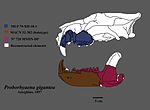Sparassodonta (redirect from Sparassodont)
showed that sparassodonts died out long before eutherian carnivores arrived in South America (aside from procyonids, which sparassodonts probably did...
61 KB (6,241 words) - 21:43, 17 May 2024
Borhyaenidae (category Sparassodonts)
taxon, Sparassodonta. Like most metatherians, borhyaenids and other sparassodonts are thought to have had a pouch to carry their offspring around. Borhyaenids...
4 KB (415 words) - 08:20, 5 April 2024
paucituberculatans and sparassodonts. Large opossums like Didelphis show a pattern of gradually increasing in size over geologic time as sparassodont diversity declined...
64 KB (5,870 words) - 21:45, 31 July 2024
mammals initially consisted primarily of metatherians (marsupials and sparassodonts), xenarthrans, and a diverse group of native ungulates known as the...
174 KB (18,117 words) - 18:05, 3 August 2024
Thylacosmilus (category Sparassodonts)
was not a felid, like the well-known North American Smilodon, but a sparassodont, a group closely related to marsupials, and only superficially resembled...
39 KB (4,440 words) - 17:24, 13 July 2024
carnivores in the northern continents and Africa. In South America, sparassodonts were dominant, while Australia saw the presence of several marsupial...
17 KB (1,652 words) - 16:01, 4 August 2024
Proborhyaena (category Sparassodonts)
proborhyaenid sparassodont that lived during the Oligocene of what is now South America. It is considered to be the largest of the sparassodonts. Proborhyaena...
8 KB (794 words) - 18:17, 13 July 2024
teeth, a feature which also convergently evolved in the saber-toothed sparassodont Thylacosmilus. The ancestors of nimravids and cats diverged from a common...
18 KB (1,486 words) - 15:19, 21 June 2024
niches for mammalian carnivores were dominated by these marsupial and sparassodont metatherians, which seem to have competitively excluded South American...
75 KB (7,747 words) - 01:29, 1 July 2024
Cretaceous–recent PreꞒ Ꞓ O S D C P T J K Pg N Lycopsis longirostris, an extinct sparassodont, a relative of the marsupials A mouse opossum (Marmosa) Scientific classification...
18 KB (1,476 words) - 20:37, 5 May 2024
phorusrhacids may have presented intense competition to predatory metatherian sparassodonts such as borhyaenids and thylacosmilids, causing the mammalian predators...
52 KB (5,290 words) - 13:01, 26 July 2024
Thylacosmilidae (category Sparassodonts)
Thylacosmilinae, within Borhyaenidae, a group of superficially canid-like sparassodonts, under the assumption that Thylacosmilus was merely a late and specialized...
7 KB (798 words) - 02:37, 6 February 2024
Paraborhyaena (category Sparassodonts)
Paraborhyaena is an extinct genus of Sparassodont, belonging to the family Proborhyaenidae. It was one of the large terrestrial predators that roamed South...
2 KB (215 words) - 02:07, 20 January 2024
sectorius A borhyaenid sparassodont Acyon A. tricuspidatus A hathliacynid sparassodont Arctodictis A. munizi A borhyaenid sparassodont Borhyaena B. tuberata...
60 KB (3,244 words) - 13:48, 3 August 2024
largest of native South American mammal predators, the sabertoothed sparassodont Thylacosmilus. The largest phorusrhacid birds may also have been able...
29 KB (2,877 words) - 20:11, 24 July 2024
hyaenodonts and even in two groups of metatherians (the thylacosmilid sparassodonts and the deltatheroideans). Μαχαιροῦς, from Ancient Greek: μάχαιρα, lit...
79 KB (8,371 words) - 19:05, 30 July 2024
phorusrhacids shared the dominant predatory niches with metatherian sparassodonts during most of the Cenozoic but declined and ultimately went extinct...
79 KB (8,071 words) - 01:47, 1 August 2024
occupied by the native typical South American groups such as metatherian sparassodonts and phorusracids that had largely gone extinct shortly prior to their...
56 KB (5,313 words) - 16:59, 15 July 2024
Hondadelphys (category Sparassodonts)
Hondadelphys is an extinct genus of carnivorous sparassodonts, known from the Middle Miocene of Colombia. The type species, H. fieldsi, was described...
2 KB (158 words) - 16:44, 1 February 2024
Pharsophorus (category Sparassodonts)
Pharsophorus is an extinct genus of borhyaenoid sparassodont that inhabited South America during the Middle to Late Oligocene epoch. Originally, Pharsophorus...
4 KB (281 words) - 18:59, 13 July 2024
reduced osseous element. This was once considered a synapomorphy with sparassodonts, though it is now thought that both groups reduced their epipubics independently...
111 KB (11,531 words) - 21:40, 5 August 2024
Eomakhaira (category Sparassodonts)
Eomakhaira is an extinct genus of thylacosmilid sparassodont known from the Oligocene Abanico Formation of Chile. It contains a single species, Eomakhaira...
1 KB (76 words) - 16:19, 15 March 2024
Mayulestes (category Sparassodonts)
Tiupampa, Bolivia in the early Paleocene. It shared its habitat with fellow sparassodont Pucadelphys, and a microbiotherid marsupial, Khasia. de Muizon, Christian...
1 KB (78 words) - 22:14, 1 April 2024
"Fragmentary skull." A multituberculate. "Gurlin Tsav skull" Indeterminate Middle or Partial skull A mysterious metatherian, possibly a sparassodont....
73 KB (4,022 words) - 17:17, 2 August 2024
mammalian and avian evolution, with the dominance of phorusrhacids and sparassodonts as predators in contrast to the North American placental carnivores...
69 KB (6,997 words) - 09:15, 10 July 2024
running away from predators, such as large phorusrhacid terror birds, sparassodont metatherians, giant short-faced bears (Arctotherium) and saber-toothed...
9 KB (772 words) - 06:46, 5 July 2024
Callistoe (category Sparassodonts)
Callistoe is an extinct genus of sparassodont. It lived during the Early Eocene, and its fossilized remains were found in South America. Unlike most of...
3 KB (401 words) - 20:48, 9 April 2023
paleoneurology of hathliacynids and insights into the Early Miocene sparassodonts of Patagonia, Argentina". Swiss Journal of Palaeontology. 143 (1). 20...
246 KB (26,158 words) - 21:41, 5 August 2024
Croft, Darin A. (17 July 2020). Eomakhaira molossus, a new saber-toothed sparassodont (Metatheria: Thylacosmilinae) from the early Oligocene (?Tinguirirican)...
394 KB (40,066 words) - 17:22, 30 July 2024
like the sabre-toothed cats, and nimravids ("false" sabre-tooths), the sparassodont family Thylacosmilidae ("marsupial" sabre-tooths), the gorgonopsids and...
137 KB (14,866 words) - 19:17, 8 July 2024























